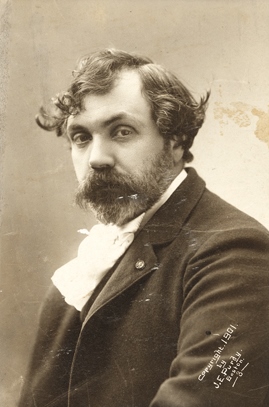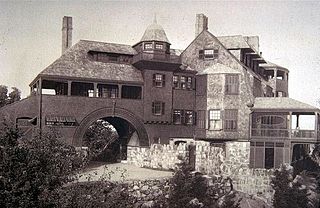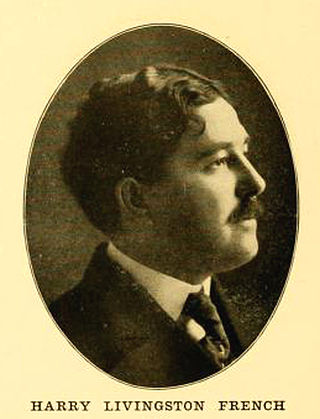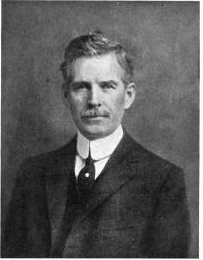Related Research Articles

Richard Morris Hunt was an American architect of the nineteenth century and an eminent figure in the history of American architecture. He helped shape New York City with his designs for the 1902 entrance façade and Great Hall of the Metropolitan Museum of Art, the pedestal of the Statue of Liberty, and many Fifth Avenue mansions since destroyed.

John La Farge was an American artist whose career spanned illustration, murals, interior design, painting, and popular books on his Asian travels and other art-related topics. La Farge made stained glass windows, mainly for churches on the American east coast, beginning with a large commission for Henry Hobson Richardson's Trinity Church in Boston in 1878, and continuing for thirty years. La Farge designed stained glass as an artist, as a specialist in color, and as a technical innovator, holding a patent granted in 1880 for superimposing panes of glass. That patent would be key in his dispute with contemporary and rival Louis Comfort Tiffany.

Karl Theodore Francis Bitter was an Austrian-born American sculptor best known for his architectural sculpture, memorials and residential work.

James Renwick Jr. was an American architect in the 19th century, noted especially for designing churches and museums. The Encyclopedia of American Architecture calls him "one of the most successful American architects of his time".

Peabody & Stearns was a premier architectural firm in the Eastern United States in the late 19th century and early 20th century. Based in Boston, Massachusetts, the firm consisted of Robert Swain Peabody (1845–1917) and John Goddard Stearns Jr. (1843–1917). The firm worked on in a variety of designs but is closely associated with shingle style.

Trowbridge & Livingston was an architecture firm based in New York City, active from 1897 to 1925. The firm's partners were Breck Trowbridge and Goodhue Livingston. They were successors to the firm Trowbridge, Colt & Livingston, founded in 1894 but dissolved in 1897 when Stockton B. Colt left the partnership.

Henry Hudson Kitson was an English-American sculptor who sculpted many representations of American military heroes.

McKim, Mead & White was an American architectural firm based in New York City. The firm came to define architectural practice, urbanism, and the ideals of the American Renaissance in fin de siècle New York City.
Cross & Cross (1907–1942) was a New York City-based architectural firm founded by brothers John Walter Cross and Eliot Cross.

William Shepard Wetmore was an American businessman and philanthropist who was an Old China Trade merchant.
John William Kitson was an English-born architectural sculptor who worked in the United States.
Robert Ellin (1837–1904) was an English-born American stone and wood sculptor.

The shingle style is an American architectural style made popular by the rise of the New England school of architecture, which eschewed the highly ornamented patterns of the Eastlake style in Queen Anne architecture. In the shingle style, English influence was combined with the renewed interest in Colonial American architecture which followed the 1876 celebration of the Centennial. The plain, shingled surfaces of colonial buildings were adopted, and their massing emulated.

The J. L. Mott Iron Works was an American hardware dealer and manufacturer during the late 19th century. It operated in New York and was relocated to Trenton, New Jersey, where it ceased operations in the 1920s.

Harry Livingston French was an American architect based in Wilkes-Barre, Pennsylvania. He designed in a variety of styles, including classical architecture and Gothic revival. His built works included numerous banks, schools, and armories.

The William K. Vanderbilt House, also known as the Petit Chateau, was a Châteauesque mansion at 660 Fifth Avenue in Midtown Manhattan, New York City, on the northwest corner of Fifth Avenue and 52nd Street. It was across the street from the Triple Palace of William Henry Vanderbilt, which occupied the entire block between 51st and 52nd Streets on the west side of Fifth Avenue.

The Church of Corpus Christi is a Roman Catholic parish church in the Roman Catholic Archdiocese of New York, located on West 121st Street between Broadway and Amsterdam Avenue in the Morningside Heights neighborhood of Manhattan in New York City. The parish was established in 1906. In 2022, the parish merged with the nearby.

Austin Willard Lord FAIA was an American architect and painter. He was a partner in the firm of Lord & Hewlett, best known for their work on the design of the former William A. Clark House on Fifth Avenue in New York.
Albert F. D'Oench was an architect of office buildings and Superintendent of Buildings in New York City. During his career, he had two partnerships, first D'Oench and Simon with Bernhard Simon. Later in his career, he partnered with Joseph W. Yost to form D'Oench & Yost, which designed large office buildings and insurance company buildings.
The New-York Directory, published in 1786, was the first extant directory for New York City and the third published in the United States. It listed 846 names. A year earlier, the first two in the country were published in Philadelphia – the first, compiled by Francis White, was initially printed October 27, 1785, and the second, compiled by John Macpherson (1726–1792), was initially printed November 22, 1785.
References
- Manufacturer and Builder, October 1884, pg 228 "A Fine Stone Structure" [cdl.library.cornell.edu]
- Trow City Directory 1879 Page 59
- Trow City Directory 1901 Page 144
- Polk's New York Co-partnerships ... 1909 Page 230
- The World's Fair At Chicago. III. The Decoration Of The Exposition. Author: Millet, F. D. Publication Info: Scribner's Magazine Volume 0012 Issue 6 (December, 1892) / Volume 12, Issue: 6, December, 1892, pp. 692–709 [cdl.library.cornell.edu]
- THE VILLARD HOUSES William C. Shopsin, AIA and Mosette Glaser Broderick 1980 Viking Press pages 47, 64
- IN PURSUIT OF BEAUTY Metropolitan Museum of Art - Rizzoli 1986, Pages 110, 120-121, 123, 425, 486 note references pg 425
- Stone; an Illustrated Magazine Frank W Holt Publishers Vol 24 January 1902 - June 1902 Editorial "The Founder of American Architectural Decoration" Pages 342-345
- Charles Schribner's Sons NYC 1893 "Some Artists at the Fair" #38
- Surogettes Court NYC Will of John William Kitson, dod Feb 3, 1888
- "History of Granite Industry in St. George, NB" Charlotte County Historical Society No 46", Miss M. Eulalia O"Halloran, page 8
- New York Times Oct 3, 1884 "Remarkable Building Work: Where the Stone of the Mutual Life Building Came From"
- The Commissioners of Patents Journal England September 15, 1874
- New York NY Tribune May 4, 1902 Page 2, American Art Industries Wood Carving
- Stone; an Illustrated Magazine - Google Books Result 1894 Vol 9 Page 470
- Stone; an Illustrated Magazine - Google Books Result 1902 Vol 24-Editorial "The Founder of American Architectural Decoration" pages 342-345
- Real Estate Record and Builders' Guide August 10, 1901 Mortgages and Assignments Borough of Manhattan
- George Titus Ferris "Gems of the Centennial Exhibition" 1877 D. Appleton & Co, NYC Pages 136-139
- The Critic: An Illustrated Monthly Review of Literature, Art 1893 Vol 22-23 Pages 391-2
- Building Trades Employers Association Vol 5 1904 page 56
- Mining and Scientific Press, Volumes 77-78 1898-99, May 20, 1899 Page 611
- Great Britain Patent Office "The Commissioner of Patents Journal" August 11, 1874 Page 2466
- Official Gazette of the United States Patent Office, May 29, 1900 Pages 776-7
- Tariff Hearings before the Committee on Ways and Means of the House of Representatives, Sixtieth Congress 1908-1909
- Columbia University Press, NYC, W. Craven, Stanford White: Decorator in Opulence and Dealer in Antiquitie newspapers.rawson.lib.mi.us/enterprise/CCE_1895_A%20(E)/issues/06-14- 1895_6.pdf "BIGGEST BRONZE CASTING"
- Yearbook of the Architectural League and Catalogue Vol 14 Pages 133, 137
- George Titus Ferris, Gems of the Centennial Exhibition D Appleton & Co Publishers NYC 1877 Pages 136-139